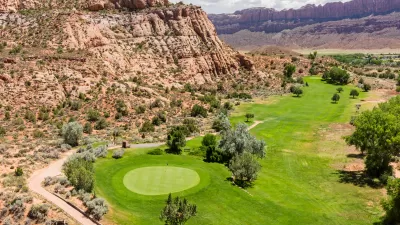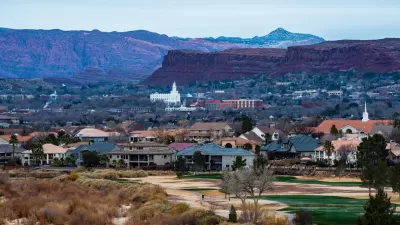Officials in the Coachella Valley seem reluctant to restrict water supplies to the many golf courses and ornamental lakes that dot the region, opting instead to cut water deliveries to a groundwater recharge facility.

When cities like Palm Springs first sprang up in the Southern California desert, the possibilities for growth seemed limitless. As Ian James explains in the Los Angeles Times, “The entrepreneurs and boosters who decades ago built the Coachella Valley’s reputation as a playground destination saw the appeal of developments awash in water, made possible by wells drawing on the aquifer and a steady stream of Colorado River water.”
But with the Colorado River at record low levels and groundwater supplies growing short, the region may need to shift its priorities. Sendy Hernández Orellana Barrows, president of the CactusToClouds Institute, “believes becoming more climate-resilient will require making better use of water by prioritizing drinking water for communities and reducing consumption that isn’t vital.” Yet local leaders have opted to cut groundwater replenishment rather than put any restrictions on golf courses, farmland, or artificial lakes.
According to James, “the water district’s managers anticipate securing the bulk of the reductions by curtailing water deliveries to a groundwater replenishment facility in La Quinta, where Colorado River water pours into ponds and percolates into the soil to recharge the aquifer.” Cástulo Estrada, vice president of the water district’s board, calls the plan “the easiest way, the less disruptive way” to temporarily cut back on water use. Meanwhile, critics like Hernández Orellana say future sustainability “demands switching to much lower water use” from all sectors.
FULL STORY: Why desert golf courses and artificial lakes remain untouched by the Colorado River crisis

Planetizen Federal Action Tracker
A weekly monitor of how Trump’s orders and actions are impacting planners and planning in America.

Chicago’s Ghost Rails
Just beneath the surface of the modern city lie the remnants of its expansive early 20th-century streetcar system.

San Antonio and Austin are Fusing Into one Massive Megaregion
The region spanning the two central Texas cities is growing fast, posing challenges for local infrastructure and water supplies.

Since Zion's Shuttles Went Electric “The Smog is Gone”
Visitors to Zion National Park can enjoy the canyon via the nation’s first fully electric park shuttle system.

Trump Distributing DOT Safety Funds at 1/10 Rate of Biden
Funds for Safe Streets and other transportation safety and equity programs are being held up by administrative reviews and conflicts with the Trump administration’s priorities.

German Cities Subsidize Taxis for Women Amid Wave of Violence
Free or low-cost taxi rides can help women navigate cities more safely, but critics say the programs don't address the root causes of violence against women.
Urban Design for Planners 1: Software Tools
This six-course series explores essential urban design concepts using open source software and equips planners with the tools they need to participate fully in the urban design process.
Planning for Universal Design
Learn the tools for implementing Universal Design in planning regulations.
planning NEXT
Appalachian Highlands Housing Partners
Mpact (founded as Rail~Volution)
City of Camden Redevelopment Agency
City of Astoria
City of Portland
City of Laramie





























